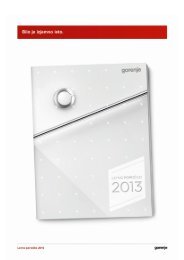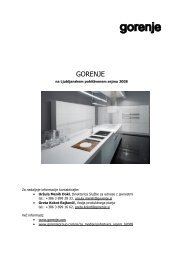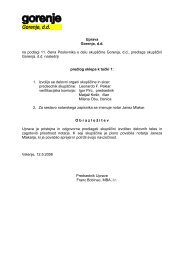Annual Report Gorenje Group 2009
Annual Report Gorenje Group 2009
Annual Report Gorenje Group 2009
Create successful ePaper yourself
Turn your PDF publications into a flip-book with our unique Google optimized e-Paper software.
In the last few years, great attention was paid to interest rate risk, which is the risk that the economic<br />
benefits of the Company may be decreased due to changes in interest rates in the market. In <strong>2009</strong> the<br />
volume of hedging against interest rate risk was decreased over the previous year’s figure, so that the<br />
share of fixed interest rates and derivatives hedging against interest rate risk amounted to 40.00<br />
percent of the Company’s lending portfolio. A lower level of fixed interest rates results from a higher<br />
indebtedness of the Company and successive maturing of certain derivatives. The Company’s<br />
management estimates that the exposure to interest rate risk has increased.<br />
Liquidity risk is the risk that the Company will fail to meet commitments in stipulated period of time due<br />
to the lack of available funds.<br />
Two credit lines in the amount of TEUR 101,126 mature in 2010. For this reason, the Company started<br />
debt rescheduling negotiations with the banks in the last quarter of <strong>2009</strong> and thus decreased its risk.<br />
The liquidity reserve as at 31 December <strong>2009</strong> in the amount of TEUR 64,637, consisting of unused<br />
revolving credit lines, short-term deposits with banks, and cash in banks, is used to ensure adequate<br />
short-term control of cash flows and to decrease short-term liquidity risk.<br />
Short-term liquidity risk is estimated to have increased even though of cash management, adequate<br />
available credit lines for short-term control of cash flows, a high degree of financial flexibility, and a<br />
good access to financial markets and funds. The reason for an increase in short-term liquidity risk is a<br />
decrease in availability of sources of funds from business partners, both buyers and sellers.<br />
Long-term liquidity risk is estimated as being moderate due to efficient operations, effective cash<br />
management, sustainable ability to generate cash flows from operating activities, and an adequate<br />
capital structure.<br />
The Company's management estimates that the exposure to liquidity risk is moderate.<br />
191<br />
<strong>Annual</strong> <strong>Report</strong> <strong>Gorenje</strong> <strong>Group</strong> <strong>2009</strong>

















